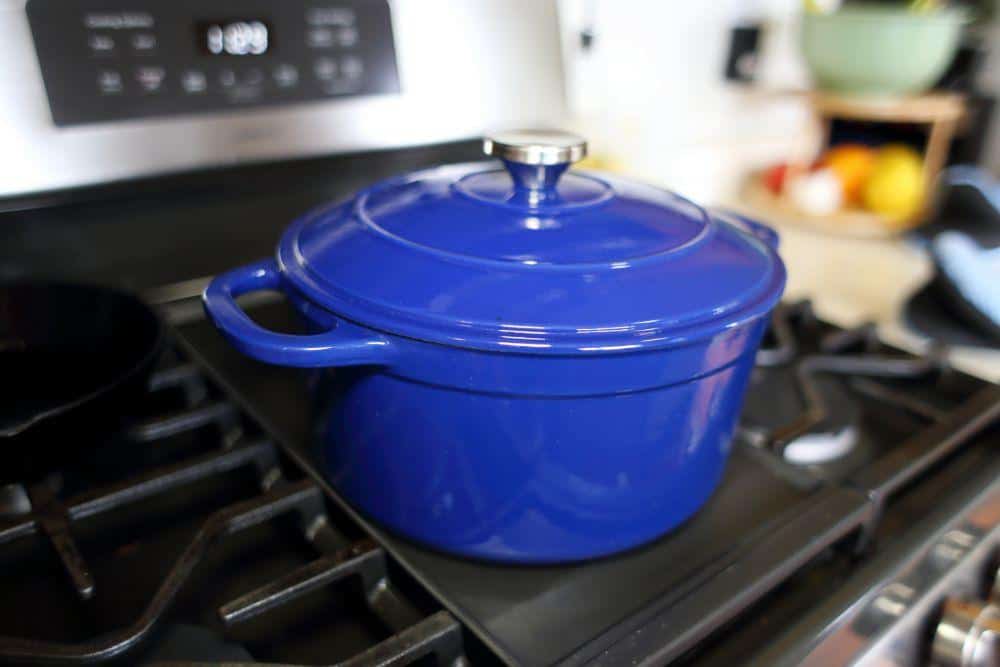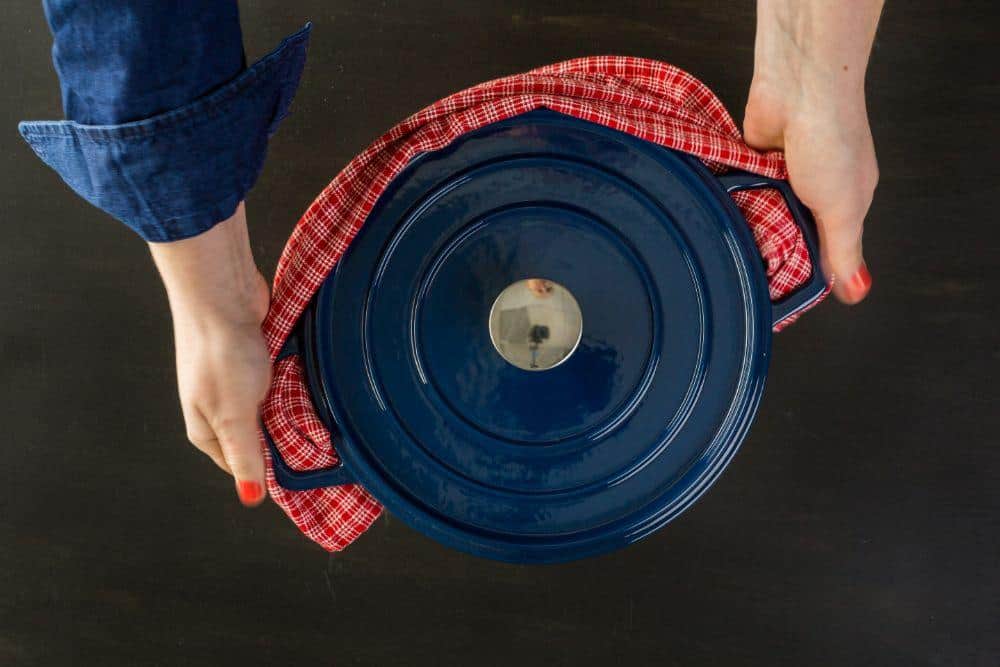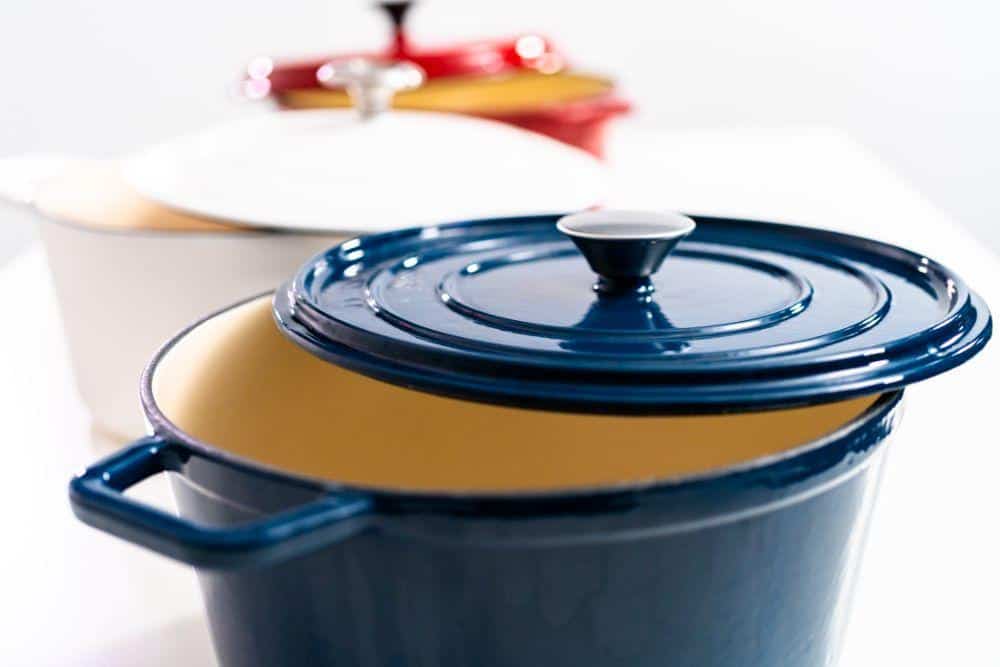A Dutch oven is one of the most versatile kitchen tools for any home chef. A Dutch oven is a deep fryer, cast iron pan, bread oven, and stock pot all in one. However, the rules surrounding how to use a Dutch oven can be contradictory and confusing.
In this guide, we'll cover whether preheating an enameled Dutch oven is recommended, how a Dutch oven works, and why people preheat a Dutch oven. We'll also cover some of the most frequently asked questions regarding this helpful kitchen tool.

A Dutch Oven Sitting on a Stovetop
Read on to learn what to do and what not to do when preheating an enameled Dutch oven.
A Dutch oven is a cast iron pot with an exterior enamel layer. The cast iron and enamel layers make it quite heavy, which is one of the reasons it's so good at retaining heat. A cast iron Dutch oven's main features make it a famously popular kitchen appliance: heat tolerance and heat retention.
A Dutch oven can reach incredibly high heat levels, far more than a standard pan or stock pot made of stainless steel or Teflon. Many Dutch ovens have a heat tolerance of up to 500 degrees Fahrenheit.
Le Creuset’s Official YouTube Channel Recommends Preheating on Low for No More than 5 Minutes
A cast iron Dutch oven doesn't just heat up well; they also distribute heat evenly. If you've ever used a pan and noticed your food cooks unevenly because certain areas get hotter than others, you know how annoying it can be. Dutch oven cooking allows for even, consistent cooking every time you use it.
A common issue for home chefs is keeping a pot or pan hot enough for those meals that take forever to cook. The pot may heat up quickly, but to keep whatever you're cooking at a consistent heat, you need to monitor and adjust the temperature constantly.

Dutch Ovens Get Hot and Retain Heat for a Long Time - Handle with Care!
For recipes that take a long time at low heat, thin pans and pots may have difficulty holding any heat and may begin to smoke if overused (a sign of poor material).
A Dutch oven is an ideal vessel for recipes requiring a long time. The pot itself heats up quite slowly compared to standard pots and pans. However, once it heats up, it can maintain a very consistent temperature for an extended amount of time.
So for recipes that require you to simmer a liquid for an ample amount of time (such as soups and stews), you can have the stovetop just barely going, and the Dutch oven will maintain the temperature.
The heat retention is also ideal for bread-making, one of the best uses of a Dutch oven. The trapped heat in the pot helps create the perfect crust on homemade sourdough bread.
Dutch ovens are versatile cookware. The simple enameled cast iron pot can function as a heavy pan, a stock pot, a deep fryer, and a bread oven. Many home chefs praise the Dutch oven for this versatility as it helps reduce kitchen clutter from having to maintain and store several different appliances.
The most common uses of a Dutch oven are:
You can preheat an enameled Dutch oven for no-knead bread recipes, but it may be unnecessary. If using a bread recipe that calls for kneading, you should not use a preheated enameled cast iron Dutch oven, as it can shock the dough and prevent it from rising as much.
King Arthur Baking (providers of King Arthur Flour) wrote an article on the differences between bread made using a preheated vs. "cold" enameled Dutch oven. The report concludes that the bread baking in a "cold" Dutch oven was nearly identical to the bread baking in the preheated oven.
A "cold" Dutch oven, in this case, is a pot placed in the oven (with bread inside) as it preheats to your recipe's set temperature. Rather than preheating the pot and then placing the dough inside, the pot and the dough heat up together as the oven preheats.
Preheating a Dutch oven can be complicated as there are some significant limitations to keep in mind:
Preheating an empty Dutch oven may cause the enamel to crack and shed, damaging the cookware permanently. If you want to preheat a Dutch oven, you should put some oil or butter in the pot before placing it in the oven or on the stovetop.

Even Though Some Manufacturers Say You Can Preheat an Empty Dutch Oven at Low Heat for a Limited Amount of Time - You Probably Shouldn’t
If you place a cold or room temperature Dutch oven directly into a hot oven or on a burning stovetop, it can permanently damage the cookware.
It would be best if you always allowed the Dutch oven to heat up WITH your heat source. Not only will this prevent damage, but it will also help with the oven's heat retention properties, as slow heat is essential for maintaining temperature for a long period.
With these points in mind, adopting the "cold" Dutch oven method may be easier and safer than preheating. The above tips mention damage to the cookware, but there are also safety concerns to consider. Dutch ovens are heavy cooking vessels, and handling a heavy container that is also very hot is dangerous.
In addition, cooking with high heat is not recommended in Dutch ovens for any cooking method. It is not necessary to use anything higher than a medium heat setting with a Dutch oven. High heat may burn your food or cause it to stick. Le Creuset provides a guide on their site to clean a Dutch oven with stuck or burnt food if you've found yourself in this situation.
Here are some frequently asked questions about preheating an enameled dutch oven.
There are two key steps to preheating an enameled Dutch oven:
Never preheat an empty, enameled Dutch oven. You can use butter or oil in the bottom of the pan before preheating. If preheated while empty, you risk the enamel cracking and shedding, and you may possibly permanently damage the pot.
Never place a cold or room temperature Dutch oven in a hot oven or on a hot stovetop. The Dutch oven must heat up WITH the heat source.
You can place the cookware in the oven and preheat it or place it on the stovetop and begin to heat it. If you drastically change the temperature of the pot (for example, placing a room temperature pot into a preheated oven), the enamel may crack and permanently damage the cookware.
If you use the lid of a Dutch oven in the cooking process, you should preheat it with the Dutch oven UNLESS the knob on the lid is plastic or wooden (any material that is not resistant to heat).
If you don't need to use the lid in the cooking process, there is no reason to preheat it.
If you use the lid in the cooking process (such as cooking or baking with the lid on), then it should be preheated with the body of the Dutch oven. The lid is not necessarily crucial to the preheating process, but if a room temperature or cold lid is placed on a hot Dutch oven, it may crack the enamel coating.
Some lower-end Dutch ovens are made with plastic or wooden knobs attached to the lid. These materials will melt if placed in an oven. Luckily, these knobs are often detachable.
One of the most famous Dutch oven companies, Le Creuset, sells the knobs for their pots separately on their site. If you want to replace the knob, you can still have a low-cost Dutch oven with the luxury of being able to place the lid in the oven with no worries.
Le Creuset is a brand that specializes in kitchen cookware. Their most famous product is their Dutch oven, so much so that many people refer to Dutch ovens simply as "a Le Creuset." A Le Creuset Dutch oven can be preheated in the oven like other Dutch ovens, and the cookware is heat-safe up to 500 degrees Fahrenheit.
Le Creuset recommends against using high heat settings with their products - including their enameled cast iron cookware - as settings above medium heat are unnecessary and may burn food and cause it to stick to the bottom of the pan.
The enamel coating of a Dutch oven will crack or shed if exposed to high heat directly. This issue is simply because the enamel should not be in contact with "dry heat" when heat comes in contact without a layer of oil or butter as an absorbent conductor.
If you want to preheat a Dutch oven, you can pour some oil or place some butter in the bottom of the pan before placing it in the oven or on the stovetop.
